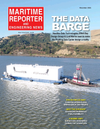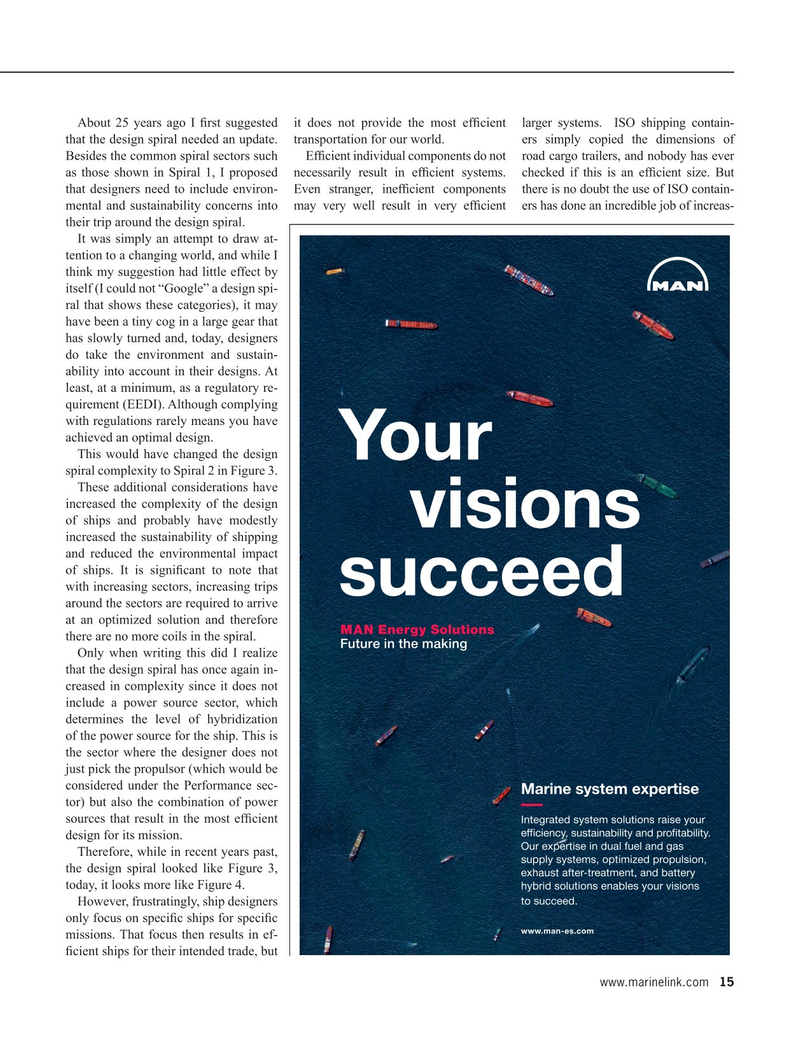
Page 15: of Maritime Reporter Magazine (November 2021)
The Workboat Edition
Read this page in Pdf, Flash or Html5 edition of November 2021 Maritime Reporter Magazine
About 25 years ago I ? rst suggested it does not provide the most ef? cient larger systems. ISO shipping contain- that the design spiral needed an update. transportation for our world. ers simply copied the dimensions of
Besides the common spiral sectors such Ef? cient individual components do not road cargo trailers, and nobody has ever as those shown in Spiral 1, I proposed necessarily result in ef? cient systems. checked if this is an ef? cient size. But that designers need to include environ- Even stranger, inef? cient components there is no doubt the use of ISO contain- mental and sustainability concerns into may very well result in very ef? cient ers has done an incredible job of increas- their trip around the design spiral.
It was simply an attempt to draw at- tention to a changing world, and while I think my suggestion had little effect by itself (I could not “Google” a design spi- ral that shows these categories), it may have been a tiny cog in a large gear that has slowly turned and, today, designers do take the environment and sustain- ability into account in their designs. At least, at a minimum, as a regulatory re- quirement (EEDI). Although complying with regulations rarely means you have achieved an optimal design.
This would have changed the design
YourYour spiral complexity to Spiral 2 in Figure 3.
These additional considerations have increased the complexity of the design of ships and probably have modestly visionsvisions increased the sustainability of shipping and reduced the environmental impact of ships. It is signi? cant to note that with increasing sectors, increasing trips succeedsucceed around the sectors are required to arrive at an optimized solution and therefore there are no more coils in the spiral.
Only when writing this did I realize that the design spiral has once again in- creased in complexity since it does not include a power source sector, which determines the level of hybridization of the power source for the ship. This is the sector where the designer does not just pick the propulsor (which would be considered under the Performance sec-
Marine system expertiseMarine system expertise tor) but also the combination of power sources that result in the most ef? cient
Integrated system solutions raise your Integrated system solutions raise your
HIÀFLHQF\VXVWDLQDELOLW\DQGSURÀWDELOLW\ HIÀFLHQF\VXVWDLQDELOLW\DQGSURÀWDELOLW\ design for its mission. 2XUH[SHUWLVHLQGXDOIXHODQGJDV 2XUH[SHUWLVHLQGXDOIXHODQGJDV
Therefore, while in recent years past,
VXSSO\V\VWHPVRSWLPL]HGSURSXOVLRQVXSSO\V\VWHPVRSWLPL]HGSURSXOVLRQ the design spiral looked like Figure 3,
H[KDXVWDIWHUWUHDWPHQWDQGEDWWHU\ H[KDXVWDIWHUWUHDWPHQWDQGEDWWHU\ today, it looks more like Figure 4.
K\EULGVROXWLRQVHQDEOHV\RXUYLVLRQV K\EULGVROXWLRQVHQDEOHV\RXUYLVLRQV
WRVXFFHHGWRVXFFHHG
However, frustratingly, ship designers only focus on speci? c ships for speci? c www.man-es.comwww.man-es.com missions. That focus then results in ef- ? cient ships for their intended trade, but www.marinelink.com 15
MR #11 (1-17).indd 15 11/4/2021 9:17:58 AM

 14
14

 16
16
